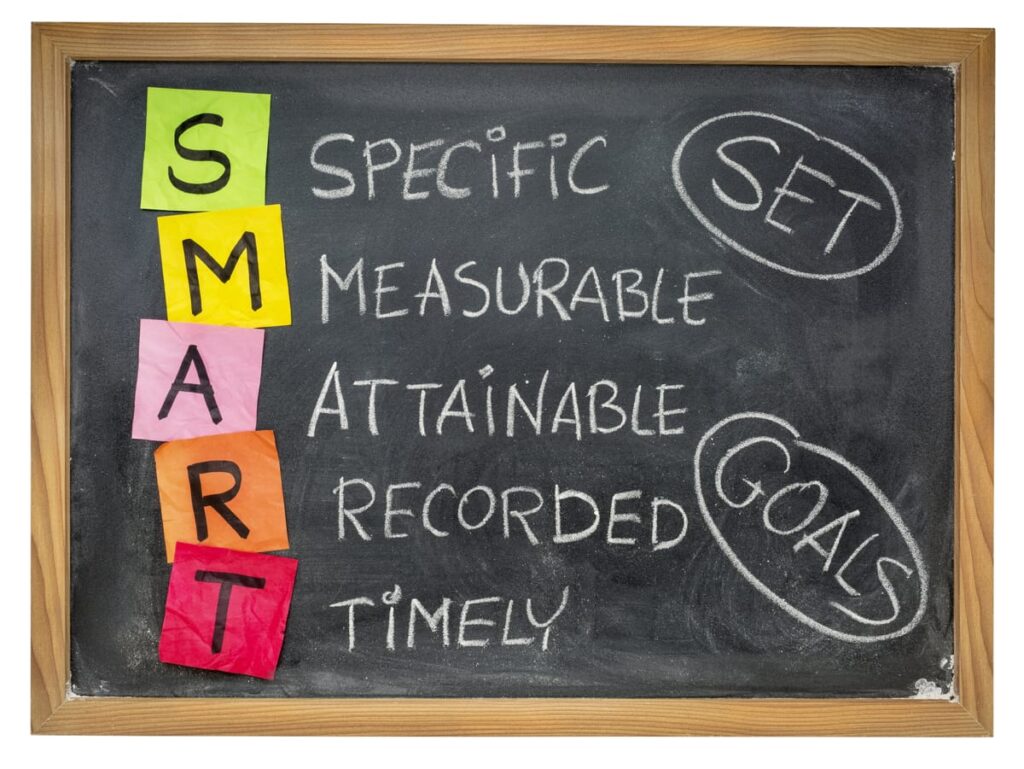June 18, 2024 • Articles • Blog • Finding Your Path
How Can You Make Sure You Are Being Realistic When Setting Goals?
In the pursuit of personal and professional growth, a critical question arises: “How can you make sure you are being realistic when setting goals?” Being able to identify the pitfalls of lofty goal setting means you’re already on the right track! But if you’re looking for tips to avoid setting goals you can’t complete, read on to learn more.
Understanding the Difference Between Dreams and Goals
Distinguishing between dreams and goals is pivotal in setting realistic expectations. Dreams are broad, often abstract aspirations that provide a source of inspiration and motivation. In contrast, goals are dreams distilled into actionable plans with specific, achievable outcomes. This distinction is crucial for realism in goal-setting; while dreams fuel our ambition, goals are the steps we take towards making these dreams a reality.
Recognizing this difference helps us create a roadmap that is both inspired by our dreams and grounded in practical steps. It’s about aligning our aspirations with our abilities and the reality of our circumstances, ensuring that the goals we set are not just extensions of our dreams but achievable milestones within our grasp.
Breaking Down Goals into Manageable Steps
Once a goal has been visualized and its importance to us understood, the next step is to make it attainable by breaking it down into smaller, manageable pieces. This methodical deconstruction serves a dual purpose: it demystifies the path to achieving the goal and provides a clear, actionable plan. Each piece of the goal, akin to a puzzle piece, represents a step that brings us closer to the full picture.
In my book, I talk about how even starting with small goals can make a massive difference in how you approach hard work. Everything from understanding why you’re doing it to the feeling of accomplishment that goes with achieving goals can hinge on how you start.
When a goal seems too daunting or complex, the inability to segment it into these pieces may be a sign that the goal needs to be reevaluated. This can let you confirm that your goals are within reach but also helps maintain motivation, as each completed step reinforces our progress and capabilities.
The Importance of Self-Reflection in Goal Setting
Self-reflection plays a critical role in setting realistic goals. It involves an honest assessment of our strengths, weaknesses, resources, and limitations. Understanding these aspects of ourselves can guide us in setting goals that are challenging yet achievable. It prevents the common pitfall of aiming too high without a realistic plan or too low, where we don’t fully utilize our potential.
Regular self-reflection ensures that our goals remain aligned with our evolving selves and circumstances, keeping them realistic and relevant. It’s a process that asks us to consider not just what we want to achieve, but what we can achieve, given our current situation and foreseeable future.
Focus on Goals that Mean Something to You
When you read my book, one message I really want to impart is the importance of making this all meaningful for you. Setting goals, among everything else, is about dictating the path you take to achieve the things that make life fulfilling. To that end, you need to think about goals that are important to you – not just ones that you think are important to those around you.
Here’s an excerpt from the book:
“I can’t stress enough the importance of crystal clear, yet realistic goals that you have absolute certainty to achieve—the kinds of goals you wake up thinking about each morning. You have to have a clear picture in your mind, so that you can start with the job you currently have, or the career you are about to embark on. Whether you work as a landscaper, wait tables at a restaurant, bust it out at a construction company, or stand on your feet all day at a hair salon, it doesn’t matter. Any vocational path you choose can be a launching point to the life you have envisioned for yourself, if you stay the course and follow your path, moving forward without looking back.”
Setting SMART Goals

The SMART framework is a powerful tool in ensuring goals are realistic. This acronym stands for Specific, Measurable, Achievable, Relevant, and Time-bound—criteria that guide the goal-setting process. A goal should be clear and specific so that you know exactly what you’re aiming for. It should be measurable to track progress and achievements.
Ensuring a goal is achievable considers one’s resources and constraints, making the goal realistic. Relevance ensures that the goal aligns with broader objectives, and setting a time-bound element creates a sense of urgency and motivates timely action. Applying the SMART criteria transforms vague ambitions into focused, attainable goals.
Learning from Past Setbacks
Past setbacks and failures are invaluable learning experiences for setting more realistic goals in the future. They provide insight into what doesn’t work, helping to refine strategies and approaches. Reflecting on these experiences can reveal limitations that need addressing or strengths that can be capitalized on.
Your intent here is to develop a growth mindset. Try to see each setback as an opportunity to learn and grow, rather than dwelling on them or allowing them to be a barrier. This perspective helps you with future goals and even give you an opportunity to set them with a clearer understanding of what is realistically achievable, based on past experiences.
The Role of External Feedback
Nobody succeeds alone! As you grow personally and professionally, you are directly or indirectly aided by dozens or more who offer you tips, guidance, and more. And that’s true too as you try to set and accomplish your goals in life.
Incorporating feedback from mentors, peers, or professionals can provide a fresh perspective on our goals, often highlighting aspects we may have overlooked or underestimated. Their thoughts can validate the realism of our goals or offer constructive criticism that helps refine them. It’s a process that encourages openness to learning and adapting, ensuring that our goals are not only realistic but also supported by insights from those who may have more experience or a different perspective. Seeking and integrating feedback is a vital step in setting and achieving realistic goals, as it helps balance personal ambition with practical advice and guidance.
Bringing It All Together
Setting realistic goals is a nuanced process that balances ambition with practicality. It involves visualizing what we truly want, breaking down these visions into actionable steps, and understanding the difference between dreams and goals. Self-reflection, applying the SMART criteria, learning from past setbacks, and seeking external feedback are all critical components of this process. By embracing these strategies, we can set goals that are not only inspiring but also achievable, paving the way for personal and professional growth that is both fulfilling and grounded in reality.
DISCOVER MORE TIPS TO HELP YOU FIND YOUR PATH – GET THE BOOK & TAKE THE COURSE!
Ken Rusk is a blue-collar entrepreneur who has started several successful endeavors and mentored hundreds of young people in their pursuit of a satisfying career and fulfilling life. Discover how Ken’s approach to life and work can help you set and achieve your goals – all while avoiding the nearly inescapable trap of college debt. Get a copy the Wall Street Journal bestselling book, Blue Collar Cash today!

